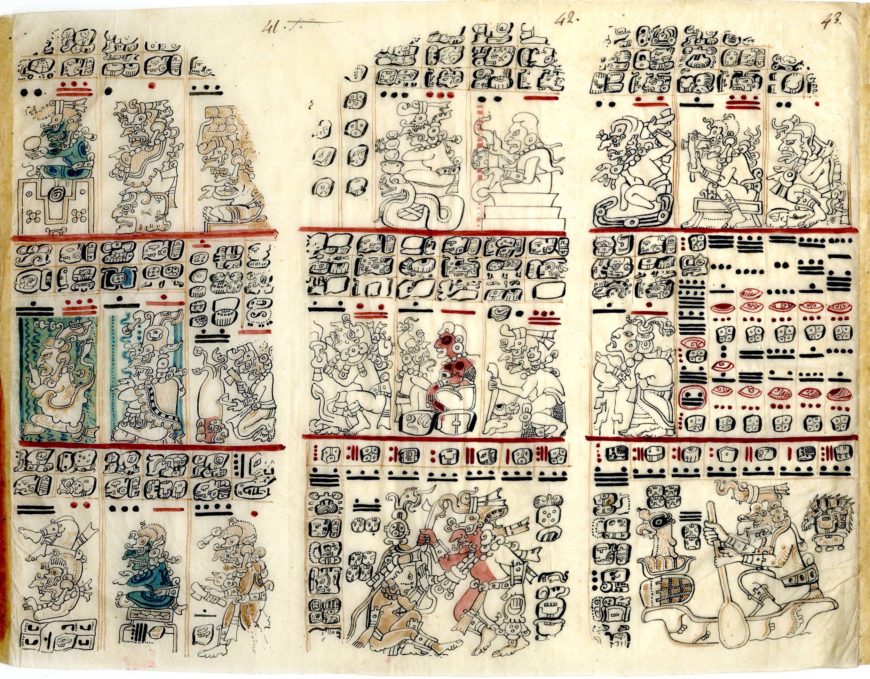
Codex Dresden, also known as Codex Dresdensis, P 1–3, original from c. 1500, facsimile from 1825–31, Lowland Maya region, south eastern Mexico and Guatemala, comprising of 74 leaves (© Trustees of the British Museum)
Across the Pacific Ocean, the Maya civilization was at its height between 300 and 900. Inscriptions have been found on monumental sculpture, public buildings, murals, pottery, shell, obsidian, bone, wood, jade, and screenfold books called codices. They were only identified as a writing system by scholars during the nineteenth century.
The majority of surviving examples of Maya writing are from the Classic period (250–900) although some date to the Late Preclassic (B.C.E.–250 C.E.). Inscriptions record calendar and astronomical information, and historical events such as alliances, wars, lineages, and marriages.
Maya glyphs were inscribed in blocks placed in horizontal and vertical rows. One or more glyphs were set in each block. It is generally read from left to right and top to bottom. The text sometimes appears in single columns, but can appear in L-shaped or other arrangements, such as on the carved lintels from the city of Yaxchilán.
Maya hieroglyphs were first identified as a writing system during the nineteenth century, when the bar-and-dot numerical system was deciphered. In the 1950s it was discovered that the script combined signs representing whole words with signs representing syllables. Certain glyphs were recognized as naming specific people and cities (known as Name Glyphs and Emblem Glyphs respectively). There were major breakthroughs in decipherment in the second half of the twentieth century and approximately 85% of the glyphs can now be read.

Yaxchilan lintel 35, Maya, Late Classic period, 600-800, From Yaxchilán, Mexico, (© Trustees of the British Museum)
Glyphs from a Maya temple
This limestone lintel was found by A. P. Maudslay in 1882 among the rubble where it had fallen from Structure 12 at Yaxchilán. Eight lintels were housed in this building. Commissioned around 500, they record nine generations of rulers at Yaxchilán and the accession of Mah K’ina Skull II, the tenth king of Yaxchilán. Mah K’ina Skull II commissioned this lintel, Lintel 35, which records a series of captures that he made in the surrounding region, concluding with a triumph over the great northern city of Calakmul, dated to 537. More than two centuries later (around 760), Bird Jaguar IV, the main character in Lintels 15, 16, and 17, reset the lintels recording his ancestry in Structure 12. The last three hieroglyphs tell us that the captives were seen as the ‘food’ of Yaxchilán’s patron deities.
Writing on ceramic vessels
Polychrome ceramic vessels were a symbol of status and power for the Maya. They were used by the elite and are found as offerings in rich burials. A large number of beautiful polychrome vases, bowls and dishes from the Late Classic period have been recovered from the Maya area, at sites such as Tikal, Holmul, and Seibal in the lowlands, and Nebaj in the highlands.

The Fenton Vase, 600-800 C.E., Maya, Late Classic period, polychrome ceramic, 17.2 cm diameter, Nebaj, Guatemala © Trustees of the British Museum
The vessels provide an important source of information about Maya society in the Classic period, with text and image illustrating historical and mythological events. The scenes depict scribes, merchants, rulers and other members of society.

The Fenton Vase, 600-800 C.E., Maya, Late Classic period, polychrome ceramic, 17.2 cm diameter, Nebaj, Guatemala © Trustees of the British Museum
This beautiful example was found at Nebaj, a Maya site in the highlands of Guatemala. The most common themes on Nebaj style polychrome vessels are tribute and warfare. The scene here represents the delivery of tribute to a seated lord. Above the basket presented to him are a series of six hieroglyphs which indicate his name and titles, while the other glyph panels correspond to those of the four figures in the scene. Their jewelry, clothing and spangled turbans adorned with flowers suggest that they are members of the elite.
© Trustees of the British Museum
Additional resources
Coe, Breaking the Maya code (London, Thames & Hudson, 1992)
Coe and J. Kerr, The art of the Maya scribe (London, Thames & Hudson, 1997)
Schele and M.E. Miller, The blood of kings: dynasty and ritual in Maya art (London, Thames & Hudson, 1986)
Tate, Yaxchilan: the design of a Maya ceremonial city (University of Texas Press, 1992)
McEwan, Ancient Mexico in the British Museum (London, The British Museum Press, 1994)
Martin and N. Grube, Chronicle of the Maya kings and queens (Thames and Hudson, 2000)
D.R. Budet, Painting the Maya universe: royal ceramics of the Classic period (Durham, London, Duke University Press in association with Duke University Museum of Art, 1994)


